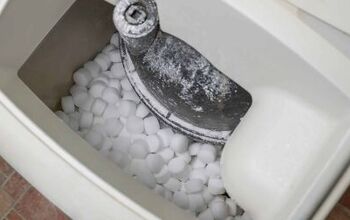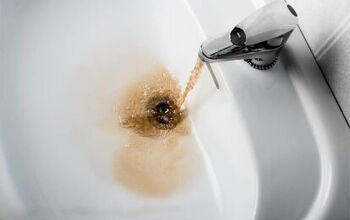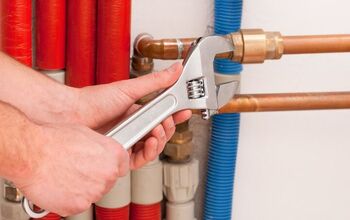Why Is The Water Softener Overflowing? (Possible Causes & Fixes)

It’s not unusual for there to be several gallons of water inside the water softener at any given time. However, there is certainly something wrong if your water softener is overflowing. If you are experiencing this, you want to know how to fix it and what is causing it immediately. Delaying this issue could cause thousands in damage and hours of work to clean.
A water softener can overflow if there is a clog in the brine tank or drain line. Inspect your brine injector and float assembly to make sure that it isn’t stuck. Repair or replace your water softener’s main piston if it continues to overflow.
If you’re ready to give your water softener a full diagnosis to get to the bottom of it, you’re in the right place. We have the tools and resources that you need. With our guide, you should be able to locate the source of the problem. With this help, you may be able to avoid calling a plumber and incurring hundreds of dollars in charges.
Follow along with our guide to learn more about water softeners and why yours may be overflowing.
Need a Water Treatment and Purification System Installed or Replaced?
Get free, zero-commitment quotes from pro contractors near you.

About The Brine Tank and Water Softener
Before you get to work on your water softener and finding the overflow issue, you should get to know a bit more about it. A water softener is not a very complicated system. However, it does have some components that you need to know about.
A water softener contains a device called a control valve. This device is responsible for controlling the flow of water in and out of the brine tank. The brine tank is the main tank in a water softener. The control valve will tell the rest of the system when it is time to clean the resin beads within.
When everything is not right with this system, it can easily lead to overflowing. When operating correctly, your water softener should continuously be pulling in water and putting it through the filtration system. If it is overflowing, something is likely wrong with the draining part of this process.
Water Softener Overflow Checklist: Troubleshooting Your Water Softener
There are a number of issues that could be causing an overflow in your water softener. Here are some of the most common issues and how you can approach a repair.
Brine Float Assembly Sticking
The most common and also easiest to fix problem with water softeners is that the brine float sticks. The brine float assembly is the device in the salt tank that turns off the water if the level gets too high. As you can imagine, this could cause quite the issue if it is not functioning properly.
The way this happens is that at times, debris can lodge the assembly shut. This prevents it from functioning properly and could mean it never sends the signal to stop bringing in water.
Diagnosis: To diagnose this, you or a professional should look at the assembly and ensure it is in working order. If the water level is above what it should be according to the water level setting, there is a good chance that the brine float assembly is sticking.
Repair: The fix for this issue is to replace the brine float assembly. This is usually done by a professional, but shouldn’t be a repair that is financially difficult to do.
Kinked Drain Line
Another possibility is that the drain line of your water softener has somehow become kinked or damaged. The drain line is responsible for guiding the water out of the tank. If it is not in working order, this can easily mean that your water softener quickly overflows. With nowhere else to go, the tank will fill and eventually overflow.
Diagnosis: The diagnosis is very easy for this issue. The drain line is visible. So, you will just need to take a look at the drain line. Most of the time if there is damage, it is very visible. You should see if there are any bends in the line that would prevent draining. Also, see if there is any visible damage to the drain line that might restrict its functionality.
Repair: If your drain line is kinked, you will simply have to bend it back into place. Try to situate the drain line in a way that would make it difficult to kink at all. Avoid putting it next to anything that moves on a regular basis. If it is damaged, you will have to order a replacement or work with a professional to repair it.
Brine Injector Clog
The brine injector is a very important component of the water softener. However, it can easily become clogged from iron or other debris. When this happens, it does not function as intended and does not bring in brine solution. This could result in the water softener adding more water than what is needed and overflowing the unit.
Diagnosis: The most simple way to diagnose this issue is to remove and clean the injector. When replaced, if the problem is still occurring, you can rule out a brine injector clog.
Repair: If your brine injector is indeed clogged, the most simple way to fix the issue is to remove and clean it. This should remove the debris from the injector and help your injector to function as intended.
Water Pressure Low
One issue that could be happening is that your water pressure is simply too low for the water softener that you are using. Many water softeners have a minimum water pressure that will work with the unit. This is uncommon as a problem, but certainly possible.
Diagnosis: The first step would be to examine your water softener and learn what the minimum water pressure is for your unit. Then you will need to measure your water pressure to your home. If your water pressure is lower than the minimum for your water softener, then you know you have a problem.
Repair: There are two possible ways to fix this. They could both be costly. The first way would be to increase your water pressure somehow. The other way would be to get a water softener that is actually designed to work with the water pressure that you have. Both of these are considered a pretty large project.
Main Piston Failure
Another uncommon, but possible problem is that your main piston is worn out. The seals in the main piston have been known to wear down early. This could allow water to leak from the chamber into the brine tank. Over time, this could slowly overflow the brine tank. Though this would be a slow way of overflowing, it is possible.
Diagnosis: If this is happening to your water softener, there are a couple of ways to tell. The best way to tell would be to examine your brine line. If water is escaping the chamber and leaking out due to seal failure, you will see water coming down this line. Water flow in this line is not unusual, but you can examine to see if it is flowing through the line after the water softener has completed its regeneration cycle.
Repair: Luckily, the repair for this issue is quite simple. It would involve replacing the main piston seal that has gone bad. This would mean that water cannot escape from the chamber to the brine tank. This repair would fix the issue of overflowing.
Need a Water Treatment and Purification System Installed or Replaced?
Get free, zero-commitment quotes from pro contractors near you.

Related Questions
How do you unclog a water softener?
One of the most common things that can happen to your water softener is a salt clog. This is not uncommon and is generally easily fixed. The salt that rests in the tank may appear loose at the top, but could very well be forming a brick at the bottom.When this happens, your tank won’t train or function properly. To fix this, you should first turn off the water supply. Use the bypass valve to do this. Fetch a broom handle or long, somewhat sharp object.Put it into the water softener and tap the buildup at the bottom. It should be relatively easy to break up. However, if you must you can hit the broom handle harder on it or find a sharper or heavier object.To prevent this from happening in the future, you should empty the tank and clean it from top to bottom. Using hot tap water is generally the best way to clean the bottom of these tanks.Once you are finished cleaning it out, only refill it to ⅔ full. Don’t add more until it is only a quarter of the way full. This should help to prevent the clog from occurring again.
Is the brine tank supposed to be full of water?
You shouldn’t be alarmed by the presence of water in the brine tank. It is fairly typical for there to be some water in the brine tank. However, there shouldn’t be very much.It is not usual for there to be more than 12 inches of water in the brine tank. It is recommended that you keep an eye on the brine tank. If there is an issue with your water softener, early signs may show in the brine tank.

We are a team of passionate homeowners, home improvement pros, and DIY enthusiasts who enjoy sharing home improvement, housekeeping, decorating, and more with other homeowners! Whether you're looking for a step-by-step guide on fixing an appliance or the cost of installing a fence, we've here to help.
More by Upgraded Home Team



























